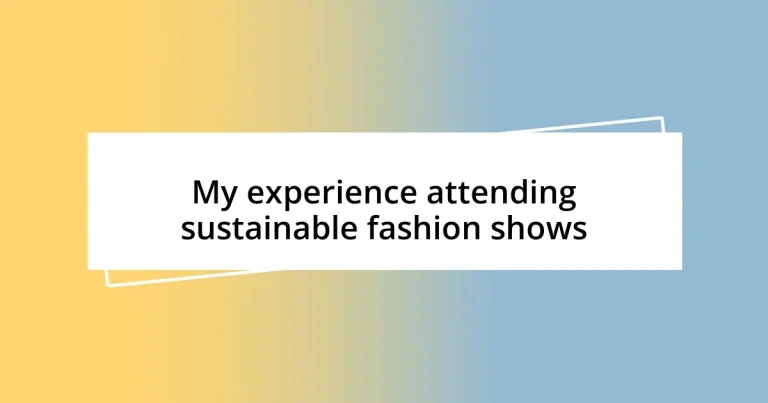Key takeaways:
- Sustainable fashion shows emphasize eco-friendly practices and ethical production, fostering a deeper connection between consumers and the stories behind garments.
- Key trends in sustainable fashion include circular fashion, biodegradable fabrics, and community engagement, reflecting an industry shift towards greater transparency and inclusivity.
- Notable designers like Stella McCartney, Eileen Fisher, and Phoebe English exemplify the integration of sustainability into fashion, promoting ethical materials and recycling initiatives.

Introduction to Sustainable Fashion Shows
Sustainable fashion shows represent a vibrant and evolving sector of the fashion industry, emphasizing eco-friendly practices and ethical production. I remember my first encounter with a sustainable fashion show; the atmosphere was electric, filled with creativity and purpose. The designs were not just about aesthetics; they had narratives woven into every fabric, urging me to ponder, “What story does my outfit tell?”
Attending these shows fosters a deeper connection between consumers and creators. I found myself not just admiring the clothes but also reflecting on their impact – the dyes used, the materials sourced, and the artisans supported. It’s fascinating how each collection showcased at these events isn’t merely a trend but rather a call to action for a more conscious way of dressing.
These events often highlight innovative concepts like upcycling and zero-waste design, sparking a sense of curiosity in the audience. I often leave inspired, wondering how I can incorporate sustainable choices into my own wardrobe. Isn’t it empowering to know that fashion can be both beautiful and kind to our planet?

Importance of Sustainability in Fashion
Sustainability in fashion is crucial, as our planet faces unprecedented environmental challenges. I vividly remember sitting in the audience, captivated as designers revealed collections made from recycled materials. It hit me then – every garment has the potential to tell a positive story, one that promotes responsibility and care rather than waste.
Moreover, sustainable fashion promotes ethical labor practices. I once spoke with a designer who shared how her brand ensures fair wages for artisans. Her passion was palpable; you could feel the pride in supporting not just her creativity but also the livelihoods of those who craft these beautiful pieces. This connection turned fashion into something far more meaningful for me.
Lastly, sustainability encourages innovation. As I walked through the show, I noticed how many brands are experimenting with biodegradable fabrics and digital fashion to minimize waste. I found myself thinking, “How can I use my buying power to support these ground-breaking changes?” Each fashion show was a reminder that sustainability isn’t just a trend; it’s a necessary evolution in the industry.
| Key Aspects of Sustainability in Fashion | Impacts |
|---|---|
| Environmental Protection | Reduces waste and minimizes resource depletion |
| Ethical Labor | Ensures fair wages and safe working conditions |
| Innovation | Drives creativity in materials and design processes |

Key Trends in Sustainable Fashion
The sustainable fashion landscape is rapidly evolving, and it’s fascinating to observe some key trends paving the way forward. For instance, I’ve noticed a significant shift towards transparency in supply chains. Designers are now eager to share where their materials come from, often displaying origin stories during their shows. It truly touches my heart to know that consumers are increasingly valuing honesty and traceability in their fashion purchases.
Here are some key trends shaping sustainable fashion today:
- Circular Fashion: Brands are launching lines designed for longevity and recyclability, encouraging consumers to return garments for repurposing.
- Locally Sourced Materials: Many designers are focusing on using regional materials to reduce transportation emissions and support local economies.
- Biodegradable Fabrics: Innovative textiles, such as mushroom leather, are gaining popularity, ensuring that fashion choices are friendly to our planet.
- Digital Fashion: Virtual collections are emerging, allowing consumers to purchase digital garments that don’t require physical production.
- Community Engagement: Events are increasingly involving local communities, highlighting artisans and promoting connection beyond just clothing.
I also find emotional resonance in the growing emphasis on inclusivity and diversity in sustainable fashion. It’s powerful to see designers showcasing models of all shapes, sizes, and backgrounds. I recall one show where models shared their personal stories, making me feel that sustainable fashion isn’t just about the clothes but about representation and advocacy. This shift adds depth to the narrative, inviting everyone into the dialogue about fashion’s future.
In essence, these trends reflect an industry awakening to its role in society and the environment. Each show feels like a celebration of creativity and responsibility, igniting a sense of hope that we can shape a better future together.

Notable Designers in Sustainable Fashion
I’ve had the pleasure of watching the work of notable designers who are revolutionizing sustainable fashion. One designer that stood out to me was Stella McCartney, whose commitment to eco-friendly practices has always been inspiring. As she presented her collection, I couldn’t help but admire the intricate details and the ethical materials used, like organic cotton and recycled polyester. Isn’t it amazing how style and sustainability can go hand-in-hand?
Another designer that left a lasting impression was Eileen Fisher. I remember her speaking passionately about her Renew program, where old garments are recycled into new ones. It made me think about the lifecycle of clothing. How often do we consider what happens to a piece of clothing after we’re done with it? I found myself identifying with her vision of a circular economy, where each item of clothing has a second chance.
Finally, the work of Phoebe English resonated deeply with me. Each collection reflects a profound respect for the environment. I was particularly moved when she showcased her use of upcycled fabrics and natural dyes. Watching her collection unfold, I considered how the stories behind these materials make them even more precious. Doesn’t it inspire you to look at clothing as an expression of our values?

Insights Gained from Attending Shows
Attending sustainable fashion shows has opened my eyes to the intersecting narratives of fashion and environmental stewardship. At one show, I remember listening to a designer discuss how their collection was inspired by marine conservation. Hearing about their commitment to using recycled ocean plastic not only blew my mind but also forged a deeper connection to the clothing itself. Isn’t it remarkable how garments can carry a story that extends beyond our wardrobes?
I’ve also noticed a palpable energy in the crowd, a shared enthusiasm for making responsible choices. At one such event, I struck up a conversation with fellow attendees who expressed their frustrations with fast fashion. It was refreshing to be surrounded by like-minded individuals united by a desire for change. We reminisced about our favorite sustainable brands, and I realized how empowering it is to support a movement that resonates so personally.
What truly resonated with me was the genuine sense of community that these shows foster. I participated in a panel discussion where designers answered audience questions about their sustainable practices. The level of transparency they exhibited was inspiring. It made me think: how often do we as consumers hold brands accountable for their promises? At that moment, I felt empowered, realizing that our voices collectively shape the future of fashion.














